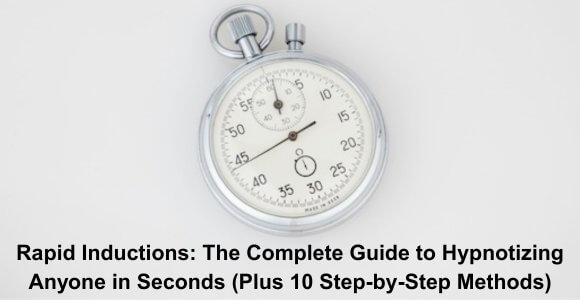
Most people picture hypnosis as a slow, gradual and drowsy process that takes 15 to 20 minutes just to move someone into a relaxed trance state so the “real” hypnosis can begin.
But what if you could hypnotize someone in minutes or even seconds?
That’s not Hollywood fiction. It’s the reality of rapid inductions — powerful techniques that create instant trance through surprise, focused attention, and precise timing. When applied ethically and with proper training, these methods can transform your effectiveness as a hypnotist, whether you’re working therapeutically, demonstrating at events, or teaching others about the power of the unconscious mind.
Here’s the fascinating part: rapid inductions aren’t about forcing someone into trance. They’re about understanding how the mind naturally responds to pattern interrupts, focused attention, and unexpected shifts in awareness. Master these principles, and you’ll discover that instant hypnosis is less about power and more about elegant communication with the unconscious.
In this comprehensive guide, you’ll learn exactly how to perform 10 proven rapid induction techniques, understand the neuroscience behind why they work, and — most importantly — how to use them ethically and safely in your practice.
What Are Rapid Inductions and Why Do They Matter?
Rapid inductions are hypnotic techniques that bypass the conscious critical factor within seconds rather than minutes. Unlike traditional progressive relaxation methods that might take 10-20 minutes, rapid inductions can establish trance in as little as 2-10 seconds.
But speed isn’t the only advantage. Rapid inductions offer several unique benefits:
- They bypass analytical resistance — Before the conscious mind can analyze or resist, the person is already in trance
- They demonstrate the power of hypnosis instantly — Perfect for building belief and expectancy in skeptical subjects
- They’re ideal for specific contexts — Street hypnosis, stage demonstrations, emergency therapeutic situations, or working with fidgety children
- They prove hypnosis is a natural state — The speed shows that trance isn’t something you “do” to someone, but a state they naturally access
The key mechanism behind all rapid inductions is what’s called a pattern interrupt — a sudden break in expected behavior that creates a brief moment of confusion or blankness. During this split-second window, the critical factor temporarily shuts down, allowing direct access to the unconscious mind.
Think about the last time someone called your name and then immediately forgot what they wanted to say. Remember that brief moment of mental suspension while you waited? That’s exactly the state rapid inductions create and utilize.
The Science Behind Instant Trance: How Rapid Inductions Actually Work
Understanding the neuroscience behind rapid inductions isn’t just academically interesting — it makes you a more effective and ethical practitioner. When you know why these techniques work, you can adapt them creatively and troubleshoot when they don’t.
The Pattern Interrupt Phenomenon
Your brain runs on patterns. From tying your shoes to shaking hands, most daily activities happen on autopilot through established neural pathways. When these patterns get suddenly interrupted, your brain experiences a momentary “reboot” — what researchers call a transderivational search.
During this brief window (typically 1-3 seconds), several things happen:
- The prefrontal cortex temporarily goes offline — This is your analytical, critical thinking center
- The amygdala becomes hypervigilant — Your brain searches for how to respond to the unexpected situation
- Suggestibility peaks — With the critical factor suspended, the unconscious becomes highly receptive to clear, authoritative suggestions
This is why a well-timed command during a pattern interrupt can trigger instant trance. You’re not overpowering someone’s will — you’re offering their confused brain a clear direction during a moment of uncertainty.
The Role of Focused Attention
Beyond pattern interrupts, rapid inductions leverage what’s called monoideism — intense focus on a single idea or sensation. When attention narrows sufficiently, peripheral awareness drops away, creating a natural trance state.
Eye fixation techniques work because sustained focus on a single point exhausts the eye muscles while simultaneously narrowing consciousness. Hand levitation methods create kinesthetic absorption. Even the shock of a sudden command focuses all attention on that single stimulus.
Research shows that this focused attention state correlates with increased theta brainwave activity — the same frequency associated with deep meditation, creativity, and hypnagogic states.
The Authority Dynamic
There’s also a social psychology component. Studies on compliance and authority (like Milgram’s famous experiments) show that people naturally respond to confident, authoritative instructions during moments of uncertainty.
This doesn’t mean rapid inductions are about dominance. Rather, they work best when the hypnotist projects calm confidence and genuine care for the subject’s experience. The authority comes from competence, not control.
When Should You Use Rapid Inductions? (And When You Shouldn’t)
Rapid inductions are powerful tools, but they’re not always the right choice. Understanding when to use them (and when to avoid them) is crucial for ethical practice.
Ideal Situations for Rapid Inductions:
Stage or Street Demonstrations When you need to establish credibility quickly and create engaging demonstrations, rapid inductions are perfect. They wow audiences and volunteers while showing that hypnosis is real and immediate.
Working with Analytical Clients Some people overthink everything. Their analytical mind becomes a barrier to trance. Rapid inductions bypass this resistance before it can fully engage.
Emergency Therapeutic Situations For acute anxiety, panic attacks, or pain management in medical settings, rapid inductions can provide immediate relief when time is critical.
Building Hypnotic Confidence When teaching hypnosis or working with someone who doubts they can be hypnotized, a successful rapid induction proves trance is accessible to them.
Children and Teenagers Young people often lack the patience for slow, progressive inductions. Rapid techniques match their naturally quick mental tempo.
When to Avoid Rapid Inductions:
First-Time Nervous Clients If someone is anxious about hypnosis, a sudden induction might increase fear rather than comfort. Build rapport first with slower methods.
Trauma Survivors Sudden movements or commands can trigger trauma responses. Always screen for PTSD or abuse history before using rapid techniques.
Physical Limitations Many rapid inductions involve physical movement (arm drops, standing, balance shifts). Check for injuries, disabilities, or balance issues first.
Without Clear Consent Never use rapid inductions as party tricks or to “prove” hypnosis works on unwilling subjects. Ethics always come first.
Cultural Sensitivity Contexts In cultures where direct commands or physical touch are inappropriate, rapid inductions may damage rapport rather than build it.
The 10 Most Effective Rapid Induction Techniques: Step-by-Step Instructions
Now let’s dive into the practical techniques. Each method below includes detailed steps, safety considerations, and troubleshooting tips. Practice these with willing volunteers, always prioritizing their comfort and consent.
1. The Handshake Interrupt (Ericksonian Pattern Interrupt)
Milton Erickson pioneered this elegant technique that turns a everyday greeting into an induction.
Step-by-Step Process:
- Begin a normal handshake with confident, friendly energy
- As your hands meet, instead of shaking normally, lift their hand slightly upward
- With your other hand, gently touch their elbow or wrist
- Break the expected pattern by holding their hand in an unusual position
- In a calm, slightly confused tone, say: “And as you notice… that’s right… you don’t know whether to shake or let go… and that confusion means you can just… relax now”
- Guide their hand down slowly while suggesting: “All the way down into comfort”
Why It Works: Handshakes are deeply automatic. Interrupting this pattern creates immediate confusion that the unconscious resolves by accepting your suggestion.
Cultural Consideration: Be aware that handshake customs vary by culture. Adapt the technique appropriately or choose a different induction.
Advanced Variation: You can create the interrupt by rotating their wrist slightly, changing grip pressure unexpectedly, or simply holding the handshake longer than normal while maintaining eye contact.
You can watch a demonstration of the Handshake Interrupt Rapid Induction here:
2. Magnetic Hands Induction
This technique builds belief through ideomotor response before triggering trance.
Step-by-Step Process:
- Have the subject hold both hands in front of them, palms facing each other, about 12 inches apart
- Suggest: “Imagine a powerful magnetic force between your hands… pulling them together”
- Reinforce: “The more you try to resist, the stronger the pull becomes”
- As their hands move closer: “Notice how they move on their own… your unconscious mind taking over”
- When hands are almost touching: “And the moment they touch, your eyes close and you drop into deep trance”
- As contact happens, reinforce: “Sleep now, going ten times deeper”
Why It Works: The ideomotor movement proves to the subject that hypnosis is working, creating expectancy and belief that makes the final suggestion irresistible.
Tip for Success: Use your own hand movements to subtly model what you’re describing. Mirror neurons will enhance the effect.
Common Mistake: Rushing the buildup. Let the magnetic sensation develop naturally over 30-60 seconds before the final suggestion.
3. The Eight-Word Hand Drop Induction
This foundational technique, sometimes called the “Eight Word Induction,” combines physical movement with perfect timing for reliable results. In its simplest form, it can be just eight words: “Press on my hand. Close your eyes. Sleep!”
Step-by-Step Process:
- Have the subject sit comfortably and raise one hand to shoulder height
- Ask them to stare at a spot on their palm while you speak
- Give suggestions: “Notice how your hand might begin to feel heavy… or light… or warm… just notice whatever you feel”
- Watch for signs of response — slight trembling, changes in breathing, defocused eyes
- When you see these signs, quickly but gently press their hand down while saying firmly: “Sleep now, letting go completely”
- Immediately follow with: “That’s right, deeper and deeper relaxed with every breath”
Why It Works: The hand drop creates a somatic interrupt while the command fills the mental gap with clear direction.
Safety Note: Always guide the hand down gently. Never force or jerk the movement. Support their arm if needed to prevent strain.
Troubleshooting: If they resist the hand drop, you moved too fast. Build more response first with additional suggestions of heaviness or magnetic pulling.
4. The Arm Levitation Drop
This combines catalepsy demonstration with sudden release for powerful effect.
Step-by-Step Process:
- Lift the subject’s arm gently to shoulder height
- Suggest: “Your arm is becoming light… floating… like a balloon is tied to your wrist”
- Test for catalepsy by slightly releasing pressure — the arm should stay up
- Continue: “The lighter it gets, the deeper you’re already going”
- Without warning, tap the arm down while commanding: “Sleep now!”
- Support their body if needed and deepen: “That’s perfect, letting everything relax”
Why It Works: The contrast between floating and dropping creates a powerful somatic interrupt that the mind resolves through trance.
Physical Safety: Always be ready to support the subject if they slump forward. Position yourself to catch them if needed.
Enhancement: Before dropping, you can add: “In a moment, not yet, but in a moment…” to build anticipation and focus.
5. Eye Fixation with Rapid Closure
The oldest hypnotic technique, accelerated for modern practice.
Step-by-Step Process:
- Hold an object (pen, finger, or small light) about 12 inches from their eyes, slightly above eye level
- Instruct: “Focus all your attention on this point… let everything else fade away”
- Begin suggestions: “As you stare, your eyelids grow heavy… heavier with each breath”
- Watch for eye fatigue signs — blinking, watering, trembling lids
- Suddenly move the object down while saying: “Eyes close NOW, sleep deeply”
- Touch their forehead gently: “Letting that relaxation flow through your entire body”
Why It Works: Eye fatigue naturally induces alpha brainwave states. The sudden command capitalizes on this natural tiredness.
Important Note: Never use bright lights or objects that could strain vision. A simple pen or your finger works perfectly.
Variation for Resistant Subjects: Have them try to keep their eyes open while you suggest heaviness. The effort creates faster fatigue.
6. The Shock or Startle Induction
Use unexpected stimuli to create instant receptivity.
Step-by-Step Process:
- Build calm focus through normal conversation
- Have them focus on your voice or a specific point
- Without warning, create a sudden stimulus — clap, snap, or tap their shoulder
- Immediately command: “Sleep NOW!”
- Before they can process, add: “That’s right, dropping deeper with every sound you hear”
- Continue with calm deepening: “Perfect, just letting go completely”
Why It Works: The startle response temporarily disconnects conscious processing, creating pure receptivity to suggestion.
Ethical Consideration: NEVER use this with trauma survivors, anxious individuals, or anyone with heart conditions. Always screen first.
Professional Tip: The shock should be surprising but not frightening. A gentle shoulder tap works as well as a loud clap.
7. The Finger Lock Challenge
Transform a convincer test into an induction.
Step-by-Step Process:
- Have them interlace their fingers tightly
- Suggest: “Press your hands together… tighter… now imagine they’re glued… welded… becoming one solid piece”
- Challenge: “Try to pull them apart and notice they’re stuck”
- As they struggle: “The harder you try, the more stuck they become AND the deeper you go”
- Release command: “When I tap your hands, they separate and you drop into deep sleep”
- Tap and command: “Now! Sleep deeply”
Why It Works: The finger lock creates cognitive dissonance — they know they should be able to separate their hands but can’t. This confusion makes them highly suggestible.
Building Success: Spend at least 30 seconds building the lock suggestion before challenging them to separate.
If It Doesn’t Work: If they pull their hands apart easily, reframe: “Perfect! Notice how your unconscious mind chose to release… now it can choose to sleep” (then use different induction).
8. The Arm Pull Induction
Popular in street hypnosis for its dramatic visual impact.
Step-by-Step Process:
- Have subject stand facing you, feet shoulder-width apart
- Take their dominant hand in a handshake position
- Suggest: “In a moment, I’ll pull your hand and you’ll feel yourself falling into deep trance”
- Begin gentle rocking: “Already beginning to sway… balance shifting… getting ready”
- With firm but controlled motion, pull their arm forward and down while commanding: “Sleep!”
- Catch and support them, guiding to a chair if available: “Perfect, going deeper”
Why It Works: The physical disequilibrium creates momentary disorientation that the mind resolves by accepting the trance suggestion.
Critical Safety Protocol:
- Always check for physical limitations first
- Have a chair ready behind the subject
- Never pull hard enough to cause actual falling
- Keep one hand ready to support their back
Building Responsiveness: Before the pull, test with gentle pushes on their shoulder, suggesting increasing relaxation with each one.
If you want a more detailed rapid induction demonstration with a step-by-step breakdown of how it works and why, you can watch this complete demonstration video here:
9.The Lièbeault Induction
Create intimate focus for profound connection and trance.
Step-by-Step Process:
- Sit directly facing the subject at comfortable distance
- Instruct: “Look directly into my eyes… just soft focus… no need to stare hard”
- Match their breathing pattern visibly
- Suggest: “As you look into my eyes, you might notice one seems darker… or larger… just notice”
- Continue: “Your peripheral vision is already fading… eyelids getting heavier”
- When you see strong signs: “Close your eyes now and sleep”
- Touch their forehead: “Dropping down ten times deeper”
Why It Works: Extended eye contact creates natural trance through focused attention while building deep rapport and trust.
Professional Boundary: Maintain appropriate professional demeanor. This technique creates intimacy that must be handled ethically.
Enhancing Effect: Slightly defocus your own eyes to model the state you want them to enter.
Watch a full demo of Igor Ledochowski performing the Liebeault induction here:
10. The Dave Elman Rapid Induction
The gold standard of rapid inductions – reliable, testable, and perfect for therapeutic work.
Step-by-Step Process:
- Create the Yes Set: “Can you imagine making a fist so tight you couldn’t squeeze any tighter? Good. Now relax that hand.”
- Eye Closure with Breath: “Take a deep breath, and as you exhale, close your eyes and relax”
- Eye Catalepsy Test: “Relax your eyelids so completely that they just won’t work. When you know they won’t work, test them and make sure they won’t work”
- Fractionation for Deepening: “In a moment I’ll ask you to open your eyes. When I pass my hand in front of them, close them and go twice as deep. Eyes open… (pass hand) …and sleep, going twice as deep”
- Repeat Fractionation: Do this 2-3 times, each time suggesting “going twice as deep”
- Mental Relaxation – Losing the Numbers: “Start counting backwards from 100. With each number, double your relaxation until the numbers fade away. By 97 or 96, they’ll be gone”
Why It Works: The Elman combines multiple principles – compliance sets, physical tests (convincers), fractionation, and mental absorption. Each stage verifies and deepens trance, making it exceptionally reliable.
Professional Advantage: Built-in depth testing at each stage means you always know exactly how deep your subject is. If one stage doesn’t work, the next one will.
Common Mistake: Rushing through the stages. Take your time with each test – the eye catalepsy and number disappearance are crucial indicators of depth.
You can watch a video about Igor Ledochowski’s modified 20-second version here:
The Essential Safety Protocols Every Hypnotist Must Follow
Rapid inductions are powerful tools that demand responsible use. Here are non-negotiable safety protocols:
Physical Safety Checklist
Before any rapid induction:
- Ask about physical limitations, injuries, or balance issues
- Check for heart conditions or anxiety disorders
- Have a chair positioned behind standing subjects
- Never use excessive force or sudden movements
- Always be positioned to support the subject if needed
- Keep the environment clear of hazards
Emotional Safety Guidelines
- Build rapport before using rapid techniques
- Explain what will happen (without giving away the surprise element)
- Get explicit consent for physical touch if your technique requires it
- Watch for signs of distress and immediately shift to comfort if needed
- Never use rapid inductions to “prove” your power or embarrass someone
- Always conclude with positive suggestions and proper emergence
Medical Contraindications
Never use shock or startle inductions with:
- Pregnant women
- People with heart conditions
- Those with PTSD or trauma history
- Individuals with epilepsy
- Anyone under the influence of drugs or alcohol
- People with severe anxiety disorders
The Consent Conversation
Before any rapid induction, establish clear consent:
“I’m going to guide you into hypnosis using a quick technique. It might involve me touching your hand or shoulder, and it will happen faster than you expect. You’ll be safe and comfortable the entire time, and you can open your eyes anytime you choose. Does that sound okay to you?”
Integration: Combining Rapid Inductions with Deepening and Change Work
A rapid induction is just the beginning. What matters is what you do once trance is established.
The Critical First 30 Seconds
Immediately after any rapid induction:
- Stabilize the trance — Use calming, rhythmic suggestions
- Deepen the state — Use fractionation, counting, or imagery
- Establish safety — Remind them they’re safe and in control
- Set up ideomotor signals — Establish yes/no finger responses
- Test depth — Use simple suggestions to gauge responsiveness
Deepening Techniques That Work Best After Rapid Inductions
Fractionation: “In a moment, I’ll count to 3 and you’ll open your eyes, then immediately close them and go twice as deep”
Progressive Relaxation: “Now that you’re in trance, let that relaxation spread from your head… down through your shoulders… deeper with each muscle that releases”
Staircase/Elevator: “You’re at the top of a staircase… with each step down, you go 10 times deeper”
Counting Deepener: “From 10 down to 1, each number doubles your depth of trance”
Transitioning to Change Work
After rapid induction and deepening:
“Now that you’re deeply relaxed and your unconscious mind is fully receptive, we can begin the work you came here to do…”
Then proceed with your planned therapeutic interventions, suggestions, or change work techniques.
Or you can follow with a quick 5-minute hypnotic gift to leave the other person feeling joyful, relaxed or even tap into inner healing. You can find a free training on how to give hypnotic gifts here.
Troubleshooting: When Rapid Inductions Don’t Work
Even master hypnotists occasionally have rapid inductions that don’t succeed. Here’s how to handle common challenges:
The Subject Doesn’t Go Into Trance
What to do: Smoothly transition as if it was planned: “Perfect, notice how your conscious mind wants to analyze… and that’s exactly why we’re going to try something different that your unconscious will love…”
Then switch to a different technique or a slower induction.
They Go Into Trance But Pop Right Back Out
What to do: This usually means insufficient deepening. Immediately re-induce: “That’s right, you went in so quickly that you surprised yourself… this time as you close your eyes, you’ll go 10 times deeper and stay there…”
They Seem Scared or Uncomfortable
What to do: Immediately shift to comfort: “You’re doing perfectly… you’re completely safe… take a nice deep breath and just relax at your own pace… there’s no rush…”
Abandon the rapid approach and use progressive relaxation instead.
They Claim “It Didn’t Work” Despite Clear Trance Signs
What to do: Validate their experience while educating: “That’s interesting you say that, because I noticed your breathing changed, your eyelids fluttered, and your muscles relaxed — all signs of natural trance. Hypnosis often feels so normal that people don’t realize they’re experiencing it. Let’s explore that feeling more…”
Physical Resistance or Stiffness
What to do: Reframe resistance as responsiveness: “Notice that tension… that’s your unconscious mind showing it’s engaged and responsive… and the moment you’re ready, that tension transforms into deep relaxation…”
Building Your Skills: Practice Exercises and Drills
Mastery comes through deliberate practice. Here are exercises to build your rapid induction skills:
Solo Practice Drills
Mirror Work: Practice your commanding presence, gestures, and timing in a mirror. Focus on projecting calm confidence.
Voice Training: Record yourself giving induction commands. Listen for authority without aggression, clarity without shouting.
Timing Practice: Use a metronome or timer to practice perfect timing. Most rapid inductions happen in a 2-4 second window.
Partner Practice Progressions
Week 1-2: Practice only the physical movements without expecting trance. Get comfortable with hand positions, arm lifts, and spatial awareness.
Week 3-4: Add verbal commands but use willing partners who will simulate trance. Focus on smooth delivery.
Week 5-6: Work with genuinely naive subjects. Start with the easier techniques (hand drop, eye fixation) before attempting more advanced ones.
Week 7-8: Practice recovery and troubleshooting. Have partners deliberately resist or act confused so you can practice smooth transitions.
Creating Your Practice Group
Find or create a practice group where you can safely develop these skills:
- Join local hypnosis meetups or practice groups
- Connect with online hypnosis communities for virtual practice
- Trade sessions with other students or practitioners
- Offer free demonstrations at appropriate venues (with proper consent and safety measures)
Ethical Considerations: Using Power Responsibly
Rapid inductions can seem like mind control to the uninitiated. This perception creates both opportunity and responsibility.
The Power Dynamic
Rapid inductions create a temporary power imbalance. The subject surrenders control while you guide their experience. This demands absolute ethical integrity:
- Never use rapid inductions to take advantage of someone
- Don’t perform them to boost your ego or impress others
- Always prioritize the subject’s wellbeing over the success of the technique
- Be transparent about what you’re doing and why
Informed Consent Is Non-Negotiable
Ethical rapid inductions require clear consent:
Good consent looks like:
- “I’d love to experience that rapid induction you mentioned”
- “Yes, you can demonstrate that technique with me”
- “I’m curious to see if I can be hypnotized quickly”
Insufficient consent looks like:
- Silence or hesitation
- “I guess so…” or “If you want to…”
- Consent given under social pressure
- Agreement from someone impaired by substances
Professional Boundaries
If you’re a practicing hypnotherapist:
- Only use rapid inductions within the scope of your training and certification
- Document consent and the techniques used in client notes
- Maintain appropriate professional boundaries, especially with intimate techniques like eye fixation
- Never use rapid inductions outside of professional contexts with clients
The Demonstration Dilemma
When demonstrating rapid inductions publicly:
- Choose volunteers who genuinely want to participate
- Never embarrass or humiliate subjects for entertainment
- Include educational content about what’s happening
- Always emerge subjects properly with positive suggestions
- Be prepared to handle unexpected responses professionally
Real-World Applications: Where Rapid Inductions Shine
Understanding where and how to apply rapid inductions makes you a more versatile practitioner:
Clinical and Therapeutic Settings
Pain Management: Rapid inductions can provide immediate relief during medical procedures or acute pain episodes.
Panic Attack Intervention: The shock of a rapid induction can interrupt the panic cycle, allowing for immediate calming suggestions.
Smoking Cessation: A dramatic rapid induction can create the “moment of change” that makes quitting feel instantaneous.
Performance Anxiety: Athletes and performers benefit from quick state changes before important events.
Educational Contexts
Hypnosis Training: Students need to experience rapid inductions to understand them. Demonstrations accelerate learning.
Public Education: Rapid inductions at health fairs or workshops show that hypnosis is natural and accessible.
Research Settings: Rapid inductions allow researchers to quickly establish consistent trance states for studies.
Entertainment and Demonstration
Stage Hypnosis: Rapid inductions create exciting moments and maintain show pacing.
Street Hypnosis: Quick techniques work better in public settings where time and attention are limited.
Corporate Training: Demonstrating rapid relaxation techniques can enhance stress management workshops.
Emergency Situations
First Responder Support: EMTs and paramedics can use rapid techniques for immediate anxiety relief.
Dental Procedures: Dentists trained in hypnosis use rapid inductions for needle phobia or procedure anxiety.
Emergency Rooms: Rapid inductions can calm agitated patients or assist with emergency procedures.
Conclusion: Mastering the Art of Ethical Instant Hypnosis
Rapid inductions represent some of the most powerful techniques in hypnosis. In seconds, you can guide someone from ordinary consciousness into profound trance — but with that power comes responsibility.
As you’ve learned in this guide, successful rapid inductions aren’t about overpowering someone’s will or tricking their mind. They’re about understanding natural psychological and neurological processes, then working with them skillfully and ethically.
Remember these key principles as you develop your rapid induction skills:
Technique is just the beginning. Knowing how to perform a hand drop or handshake interrupt is important, but understanding when and why to use it matters more.
Safety always comes first. No successful induction is worth risking someone’s physical or emotional wellbeing. Screen carefully, position yourself properly, and always be ready to support and protect your subject.
Consent is non-negotiable. Rapid inductions should only be used with clear, enthusiastic consent from informed participants.
Practice creates mastery. These techniques require precise timing, confident delivery, and smooth execution. Dedicate time to deliberate practice before using them professionally.
Integration is everything. A rapid induction is just the doorway to trance. What matters is how you use that state to create positive change.
Whether you’re a practicing hypnotherapist looking to expand your skills, a stage hypnotist wanting to create more dynamic demonstrations, or simply someone fascinated by the power of the mind, rapid inductions offer incredible possibilities.
Use them wisely. Use them ethically. And always remember that the true power of hypnosis lies not in controlling others, but in empowering them to access their own inner resources for positive change.
Next Steps: Deepen Your Hypnosis Mastery
Ready to take your rapid induction skills to the next level?
You can find a free training on How To Do Hypnotic Instant Inductions here (just cover S&H).
This video crash course takes you through all the necessary steps so even if you are a complete novice, with zero hypnosis experience, you can start using rapid inductions and make it a regular part of your practice. So go ahead and dive in!









![[ADVANCED GUIDE] How To Master Hypnotic Regression Therapy - Part I: Essential Principles To Profoundly Transform Your Subject’s Emotional Trauma [ADVANCED GUIDE] How To Master Hypnotic Regression Therapy - Part I: Essential Principles To Profoundly Transform Your Subject’s Emotional Trauma](https://hypnosistrainingacademy.com/wp-content/uploads/2016/09/hypnotic-regression-therapy-essential-principles.jpg)
![Yogic Breathing For Hypnosis: 3 Easy Techniques To Ground & Relax Your Clients Before Inducing A Hypnotic Trance [Includes Infographic] Yogic Breathing For Hypnosis: 3 Easy Techniques To Ground & Relax Your Clients Before Inducing A Hypnotic Trance [Includes Infographic]](https://hypnosistrainingacademy.com/wp-content/uploads/2019/05/yogic-breathing-for-hypnosis.jpg)

